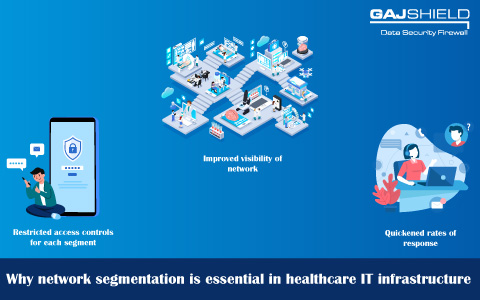Why network segmentation is essential in healthcare IT infrastructure
As you already may know, healthcare is always a ripe hunting ground for hackers and other cybercriminals to launch their attacks. There are multiple reasons for this some of the main ones being the incredible amount of digitization that is prevalent in healthcare today, the sensitive and personal nature of data present in the personal medical records of patients, and the possibility that hijacking devices such as surgical robots or pacemakers remotely can cause health and operational malfunctioning, which can lead to the death of patients (who may be targeted by negative elements).

To keep such threats at bay, and also to keep elements such as malware, phishing, and viruses away, healthcare systems need to employ the concept of network segmentation. In the simplest terms, network segmentation is defined as a data security approach in which a connected data network is divided into multiple segments. Each segment can have its own individual working mechanism and work as an individual network. This breaking up of networks and their resources allows administrators to monitor and control network traffic and regulate data on the basis of individual segment policies. But how can network segmentation positively impact the data security-related attributes of hospitals and clinics?
Restricted access controls for each segment
Hospitals need to protect their networks from external and internal attacks. Internal attacks are more frequent and damage-causing than you may know, given that not many businesses would be always alert and suspecting when it comes to their own employees. Taking advantage of this, many internal elements would exploit data security weaknesses in healthcare infrastructure. For instance, data entry operators within a clinic may use a loophole in the network to illegally direct money toward their own bank account.
To counter such activities and other kinds of insider attacks or social engineering attacks, which involve data security attackers using the naivety of employees in your business to access your hospital's data networks and automated devices, segmentation limits user access to a single part of the entire network. The main advantage of this is that the data security damage caused by malicious or naive insiders will only be restricted to specific networks as they will not have access to other parts of a hospital's data security network. This is called the Least Privileges policy for employees. This policy allows companies to know exactly who the perpetrator of an attack is and restrict their radius of damage.
This particular benefit is extremely important as it is often believed that a data network is only as strong as its weakest (or, also, in this case, the shadiest) link. This means that a majority of data security attacks take place due to things such as clumsy employees not following cyber-hygiene and password-protection rules. Or, insiders purposely open malicious emails and click on harmful links to unleash myriad types of cyber-attacks on the entire digitized healthcare infrastructure. A painstakingly-built, segmented network can help hospitals overcome this problem by taking away individuals’ ability to access the entire network and do as they please there. Accordingly, this also means that hospital IT administrators have more control over the data network proceedings as compared to the older, traditional way of data management.
Improved visibility of network
Doctors, healthcare experts, and the data security team of a hospital always need to monitor and keep an eye on the various medical records, patient history data, medicinal inventory, and other details. Carrying out monitoring for singular networks is hard because of the large amount of data and constant access of individual users from time to time. However, segmented networks eliminate this problem of visibility. Segmented networks enable such administrators to utilize the medical resources with perfect efficiency and also provide a lot of transparency to digitized hospital operations.
Every piece in a segmented network is properly transparent and defined. By ‘well-defined’, we mean that the boundaries of each network are properly categorized, meaning that admins know exactly up to which place a certain employee is responsible for work, and when the boundary approaches for that segment, from where does the accountability of another employee begins. While this may make healthcare data networks decidedly slower, it also lets admins know about any network changes made that can cause data security damage to overall healthcare or patient records-related data.
Overall, improved visibility is one of the prime reasons why healthcare centres and clinics should break up their data network into manageable, bite-sized pieces for easy management of resources and data.
Quickened rates of response
As stated earlier, damage control is much easier with segmented networks as compared to regular networks. This is possible, mainly, because of the simplification of monitoring such networks. Another benefit of segmented networks is that it triggers an immediate response from data security teams and tools once a data security threat is detected anywhere across the healthcare IT network. This is one of the reasons why the metaphorical cancer of a data security attack does not spread to different parts of the healthcare network, corrupting data and automated machines in the process.
More importantly, segmentation vastly improves the endpoint security of a healthcare data network. Segmentation for endpoint devices such as IoT sensors or ECG machines that collect data makes it easier for hospitals to digitize their operations further.
GajShield’s data security experts and tools can help you with data segmentation. Kindly contact us to know more about our data security products and services.
Get In Touch With Us
Subscribe to our Newsletter
2025 © GajShield Infotech (I) Pvt. Ltd. All rights reserved.
